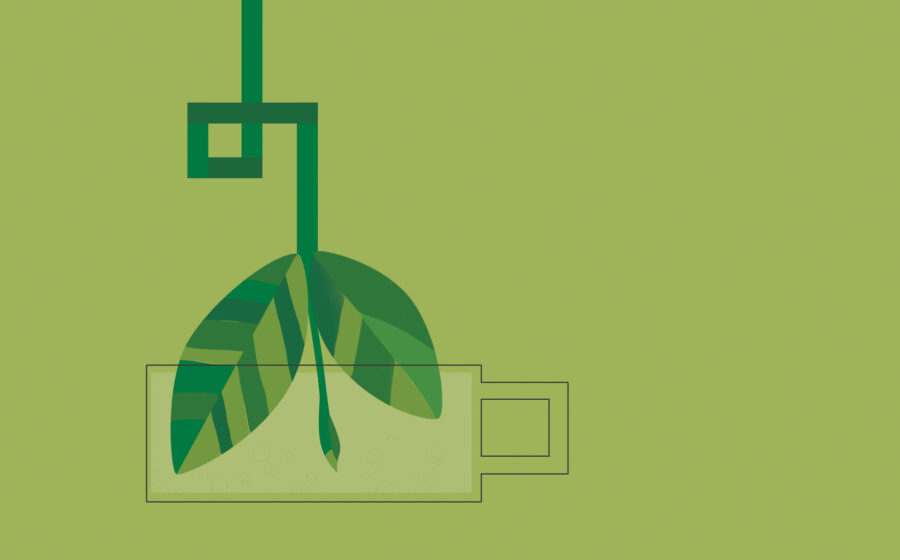[H]ere is the conundrum: tea goes slow, most of the time. Ceremonial, temperamental, manifold; teas take effort, and we gladly give it, knowing the prize on the other side can be otherworldly. But with tea’s increased appeal, there arise obstacles to its ritual. Even tea-adoring customers get rushed or tired or impatient, and tea’s gentle slowness becomes less attractive.
Aiming for a refined experience on the go, equipment manufacturers, some old and some new, are introducing machines that impress visually, complement a shop’s thought-out tea menu, and offer relief from the pressures of longer wait times, without sacrificing proper brewing. Some of those devices, integrating science and novel technology, are broadening our understanding of extraction. All of them make a case for a more streamlined tea experience. Tea’s soothing nature doesn’t have to change, but the way we brew it can.
Tower of Power

For years the staple of this shift has been the hot water tower. Hot water dispensers are the workhouse of tea-brewing in most cafés. Their primary appeal is volume—they can handle a rush. But they also offer consistency, reliability, durability, and convenience to the busy barista. Traditionally their function began and ended at hot water, but with increased attention being given to tea temperatures and variables, a single, if steady, temperature became a drawback. Today’s towers go further, offering the temperature control that is so important to getting tea right. They’ve also slimmed down, in some cases drastically, perfect for minimalist bar areas. Bunn’s brewers come in colors like copper, red, white, and black. Wilbur Curtis’s aeration feature pumps oxygen into water at regular intervals to improve overall water quality. LED displays help track temperature and control aeration.
Steamed Up

Luckily, there are compact steamers and even under-counter steaming solutions that allow expert milk- and alternative-milk-steaming, but leave room for other infusions to take center stage. Standalone steamers from Astoria and Astra come in single and double-wand models. Modbar’s steam module is designed to be both elegant and durable, with a chic, levered tap allowing for precise pressure control, and a hidden, undercounter module for powering up to two wands.
The Crucible

The Steampunk brewer, from Salt Lake City’s Alpha Dominche, can be found in some of the world’s premiere cafés and roasteries. But one of its first homes was in Chicago, at Adagio Tea. CEO Thomas Perez says about half of Alpha Dominche’s customers are in tea, proving that it isn’t always coffee that gets eye-catching contraptions. In both two- and four-crucible models, the Steampunk is basically a tricked-out siphon brewer designed to offer the barista total control of a unique, steam-agitation process. Baristas get say over temperature, time, filter, and agitation (with a handy app for storing recipes and settings). And customers get an expertly brewed cup, and a show. The process is fast, but even if it wasn’t, waiting is no longer a laborious affair.
“Our machine is very visual. You see the whole brewing process, how the leaves are opening, how the color is changing, and so forth. I think it’s very entertaining,” says Perez.
In a Vacuum

Tea professionals know that brewing an oolong is not the same as brewing a sencha, as brewing a white tea, or blending matcha. In the café this means individualized attention to each order. Sometimes that’s fine, but in high-traffic shops, it might turn away potential business. Bkon’s RAIN (reverse atmospheric infusion) process can unfurl a rolled oolong after a ninety-second cycle, a process that normally takes multiple steepings, over ten to fifteen minutes. It does matcha, too, infuses chai, gets flavor out of tricky tisanes, and more. In the machine’s visible, central glass chamber, a whole menu of leaves come to life, quickly and consistently, with programmable variables and a database of recipes in the cloud.
“It’s not about automated technology,” says Bkon co-founder Lou Vastardis. “It’s about changing the way that extraction occurs.”
The secrets to this method are hidden down on a molecular level. The brewer’s multiple vacuum cycles remove the air in organic material on a deeper level than hot water alone, extracting more flavor, faster, at lower temperatures and in denser liquids. The brewer looks a little like a robot, and its appeal to café owners is immense.
Speediness is the key pull. The Bkon brews fast, is self-cleaning with each cycle, very easy to use, and easy to program. That’s why East Coast tea chain Capital Teas chose to outfit its higher volume shops with Bkon brewers. Owner Manelle Martino says the brewer strips eight- to ten-minute brews down to ninety seconds, eliminating long wait times and allowing more customers to be served at those shops. “It also gives our customers a bit of theater while they wait for their teas to brew,” she says.
[T]here is still room for a meditative take on tea, and there will always be shops that tenderly whisk each cup of matcha, and encourage customers to relax over multiple steepings of a high mountain oolong. But partly to keep up with tea’s shift to hip, and partly from a natural evolution, brewing machines have more personality and more power than they once did. Their place in tea makes more sense. In a way, it is tea catching up to espresso. “Adding a machine to this process makes it something you cannot make at home,” says Perez.
Happily for tea and those who love it, it’s now easier than ever—and stylish, and more commonplace—to find accessible, expertly brewed leaves. In an industry of technique obsession, it’s just one more reason to geek out.
—Regan is Fresh Cup’s associate editor. Illustrations by Cynthia Meadors.














